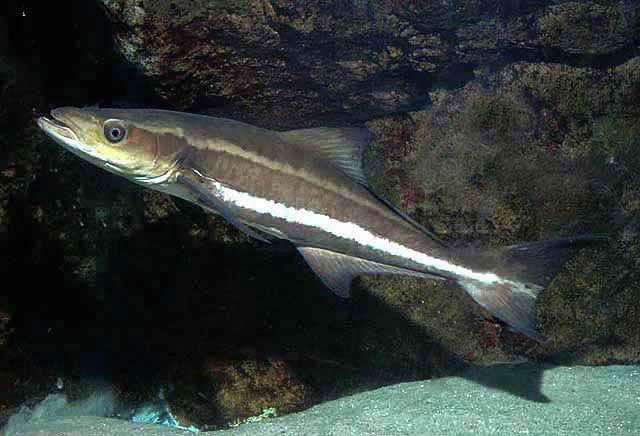Cobia, Rachycentron canadum (Linnaeus 1766)

Cobia, Rachycentron canadum. Source: Ross D. Robertson / Shorefishes of the Greater Carribean. License: CC BY Attribution-Noncommercial-ShareAlike
This large distinctive fish resembles remoras and suckerfish (family Echeneidae), although Cobia lack the dorsal sucking disk. They have a broad, flattened head, tiny scales, a long, low soft dorsal fin preceded by short spines unconnected by membranes, and a slightly shorter anal fin.
The lower jaw protrudes beyond the upper, the soft dorsal and anal fins are distinctly higher anteriorly than the rest of fin. The white stripe along the sides may fade after death.
Cobia are the only species in the family Rachycentridae.
Video of Cobia along with shark suckers and rainbow runners (Cobia footage about 1.5 minutes into the video).
Video of Cobia swimming with a Whale Shark at Flat Rock, North Stradbroke Island, Queensland, March 2017.
Cobia, Rachycentron canadum (Linnaeus 1766)
More Info
|
Distribution |
Found worldwide in all tropical and subtropical continental waters, except in the Eastern Pacific. The species is widespread and common over shallow coral reefs, rocky shores, and occasionally in estuaries throughout its range to a depth of 200 m. The Cobia is often seen at the surface, frequently accompanying large rays and sharks, especially Whale Sharks. It is rare in temperate waters in Australia. |
|
Features |
Dorsal fin VII–IX (not interconnected) + 26–33; Anal fin II–III, 22–28; Caudal fin 17; Pectoral fin 21–22; Pelvic fin I, 5; Gill rakers 2 + 9–10. Body depth about 18% SL; head length about 24% SL. Lower jaw protruding; band of fine teeth on jaws, roof of mouth and tongue; front of soft dorsal and anal fins distinctly higher than rest of fin; pectoral fins pointed, upper rays longest; posterior margin of caudal fin concave in adults, upper lobe longer than lower, fin rounded in juveniles. Moderately elongate near coastal fish with broad, flattened head, tiny scales, long, low soft dorsal fin preceded by short spines unconnected by membranes and slightly shorter anal fin. Lower jaw protruding; band of fine teeth on jaws, roof of mouth and tongue; front of soft dorsal and anal fins distinctly higher than rest of fin; pectoral fins pointed, upper rays longest; posterior margin of caudal fin concave in adults, upper lobe longer than lower, fin rounded in juveniles. |
|
Size |
Maximum size is 200 cm fork length (FL), commonly to 110 cm FL. |
|
Colour |
Dark brown above, creamy-white below, with two silvery-white or bronze stripes from the head to base of tail; only one dorsolaterally in large adults. |
|
Feeding |
Carnivore, feeds on crustaceans, squid and fishes. |
|
Biology |
Forms large spawning aggregations usually in open water, and spawning 15-20 times per season, |
|
Fisheries |
The large size and strong fighting abilities makes the Cobia a popular sports fish. It is most frequently taken on lures or with live fish bait. The dry white flesh is of excellent eating quality. |
|
Species Citation |
Gasterosteus canadus Linnaeus 1766 Syst. Nat. 12, 1(1): 491. Type locality: Carolina, U.S.A. |
|
Author |
Gomon, M.F. & Bray, D.J. 2017 |
|
Resources |
|
Cobia, Rachycentron canadum (Linnaeus 1766)
References
Allen, G.R. & M.V. Erdmann. 2012. Reef fishes of the East Indies. Volumes I-III. University of Hawai'i Press, Tropical Reef Research.
Bignami, S., S. Sponaugle & R.K. Cowen. 2013. Response to ocean acidification in larvae of a large tropical marine fish, Rachycentron canadum. Global Change Biology 19(4): 996 DOI: 10.1111/gcb.12133
Brown-Peterson, N.J., R.M. Overstreet, J.M. Lotz, J.S. Franks & K.M. Burns, 2001. Reproductive biology of cobia, Rachycentron canadum, from coastal waters of the southern United States. Fish. Bull. 99: 15-28.
Collette, B.B. 1999. Family Rachycentridae (p. 2655) in Carpenter, K.E. & Niem, T.H. (eds). The Living Marine Resources of the Western Central Pacific. FAO Species Identification Guide for Fisheries Purposes. Rome : FAO Vol. 4: 2069-2790 pp.
Collette, B.B., Curtis, M., Williams, J.T., Smith-Vaniz, W.F. & Pina Amargos, F. 2015. Rachycentron canadum. The IUCN Red List of Threatened Species 2015: e.T190190A70036823. http://dx.doi.org/10.2305/IUCN.UK.2015-4.RLTS.T190190A70036823.en. Downloaded on 12 April 2017.
Ditty, J.G. & R.P. Shaw. 1992. Larval development, distribution, and ecology of cobia Rachycentron canadum (family: Rachycentridae) in the northern Gulf of Mexico. Fish. Bull. 90: 668-677.
Franks, J.S., N.M. Garber & J.S. Warren.1996. Stomach contents of juvenile cobia, Rachycentron canadum, from the northern Gulf of Mexico. Fish. Bull. 94: 374-380.
Gloerfelt-Tarp, T. & P.J. Kailola. 1984. Trawled fishes of southern Indonesia and northwestern Australia. Australian Development Assistance Bureau, Australia, Directorate General of Fishes, Indonesia, and German Agency for Technical Cooperation, Federal Republic of Germany. 407 p.
Gomon, M.F. 2008. Families Rachycentridae and Echeneidae. pp. 571-575 in Gomon. M.F., Bray, D.J. & Kuiter, R.H (eds). Fishes of Australia's Southern Coast. Sydney : Reed New Holland 928 pp.
Hoese, D.F. & J.R. Paxton, J.R. 2006. Rachycentridae (pp. 1144-1145). In: Beesley, P.L. & Wells, A. (eds) Zoological Catalogue of Australia.Volume 35 Australia : ABRS & CSIRO Publishing Parts 1-3 2178 pp.
O'Toole, B. 2002. Phylogeny of the species of the superfamily Echeneoidea (Perciformes: Carangoidei: Echeneidae, Rachycentridae, and Coryphaenidae), with an interpretation of echeneid hitchhiking behaviour. Canadian Journal of Zoology 80(4): 596-623.
Russell, B.C. & W. Houston. 1989. Offshore fishes of the Arafura Sea. The Beagle 6(1): 69-84.
Shaffer, R.V. & Nakamura, E.L. 1989. Synopsis of biological data on the cobia Rachycentron canadum (Pisces: Rachycentridae). NOAA Tech. Rep. NMFS 82. 21 pp.
Smith, M.M. 1986. Family No. 212: Rachycentridae. pp. 661-662, 1 fig. In: Smith, M.M. & Heemstra, P.C. (eds). Smith's Sea Fishes. Johannesburg : Macmillan South Africa xx + 1047 pp. 144 pls.








